#amman illustration
Photo

Amman Panoramic View. By International Media Services, 1995.
72 notes
·
View notes
Text
me thinking my dialect is undetectable and then 2 seconds into meeting anyone they're like: soooooooo are u from damascus or what???
#to illustrate my mom is syrian and my dad is Palestinian but considering everything~ my dialect is almost purely syrian lol#but weve all been born in amman it's just so silly how strong the syrian dialect is#city-specific and all too
4 notes
·
View notes
Text

September 22, 2022.
#amman#jordan#wall#mural#painting#people#faces#illustration#grafitti#cityscape#skyline#street#middle east#summer#september#2022#komalantz#urban#habitat
2 notes
·
View notes
Photo

1925 Alberto Martini, The Marchesa Luisa Casati as Cesare Borgia. Crayon, 280 x 125 cm.
Private Collection Audouy.
#1925#costume sketch#illustration#alberto martini#martin#cesare borgia#crayon#costume#Private Collection Audouy#marchesa luisa casati#Luisa Casati Stampa di Soncino#Marchesa Luisa Casati.#luisa casati#marquise casati#marchesa casati#Marchesa Casati Stampa#luisa amman casati#Luisa Adele Rosa Maria von Amman#Luisa Adele Rosa Maria Amman#Luisa Amman#amman#Marquise Casati Stampa di Soncino#Marchesa Casati Stampa di Soncino#Luisa Marchesa Casati Stampa Di Soncino
13 notes
·
View notes
Photo

Commission of the new studio of the Palestinian brand ‘kuvrd’. A beautiful old building located in Jabal Amman. Zoom in to see the details on the doors and balcony!
Click here to learn about their cool Black Friday event
17 notes
·
View notes
Text
Underground Amman Jordan

View On WordPress
#Alaeddin Rahmeh#Amman Rainbow Street#Amman Streetart#Amman Underground#Annual Baladk Street Art Festival#Arab Poet Al-Mutanabbi#Artist House of Dreaming Amman#Beatboxing#Breakdancing#Graffiti/Streetart.#Jordan Ramadan 2023#Mahmoud Darwish Palestinian Poet#Rapping#Sardine Wall Illustrator
2 notes
·
View notes
Text
16th c. Costume Books, a Problematic Source for Dress History

But did they really dress like this?
Costume books and costume albums are a popular source for dress historians, historical costumers, and reenactors researching 16th and early 17th c. Europe. There are good reasons for this. They are primary source documents (at least sometimes), and they show the clothing of cultures and social groups that are difficult-to-impossible to find in other types of period art, like the Irish and rural peasants. Examples of these books include Trachtenbuch des Christoph Weiditz, Habiti antichi et moderni di tutto il Mondo di Cesare Vecellio, and Théâtre de tous les peuples et nations de la terre avec leurs habits et ornemens divers. These books are, however, deeply problematic as a dress history source for several reasons. In this post, I will discuss the ways they are problematic and how those of us researching historical dress can gain a better understanding of what the people shown in these books were actually wearing. I have broken down the problems with using these images into 4 areas.
Embodied biases:
The creators of these books were, at least sometimes, prejudiced against the cultures they were portraying, and these biases may have affected how they characterized these cultures. Hans Weigel, author of Habitus praecipuorum populorum, characterized his native German fashion as modest and virtuous and characterized elaborate Italian fashions as decadent and corrupt. Weigel considered these 'strange' foreign fashions a threat to the 'civilized' German fashion he favored (Bond 2018). This bias might have motivated Weigel to idealize his portrayal of German fashion or to exaggerate the strangeness of Italian fashion in order to scare his readers away from trying it.
Weigel's dislike of flashy foreign fashions seems mild in comparison to the bigotry of some of his peers. Flemish artist Lucas de Heere and French artist François Desprez both labeled the Scottish 'savages' in their books. Jost Amman's description of a purported Turkish sex worker in the German edition of Gynaeceum, sive Theatrum mulierum, is appallingly bigoted:
"A Turkish Wh*re: This is a prostitute, who sells her impure body for dirty money to a lover that pleases her. With the earnings of this sin she dresses herself prettily and beautifully, in order to attract the Turks even more easily with her false ornaments." (translation from Ilg 2004)
Considering the blatant bigotry he shows here, I wouldn't anything about trust Amman's depictions of sex workers, Turks, or any other non-Western Europeans. Or any other women, really.
Sights unseen:
Even when costume book creators weren't actively trying to perpetuate their biases through their work, their ignorance could still cause problems. These artists did not always visit the countries whose costumes they painted. They relied on other artists' work or even just verbal descriptions to fill in the gaps in their knowledge. The resulting images can distort the cut, construction, and material of the clothing.
For example, the Turkish women in this original woodcut by Pieter Coecke van Aelst are wearing shawls or scarves with long fringe wrapped around their heads and shoulders. In the Christoph von Sternsee costume album's illustration based off Coecke van Aelst's print, the fringed shawl has become a strange, tailored hood with a panel of pleated cloth attached to either it or the gown below.
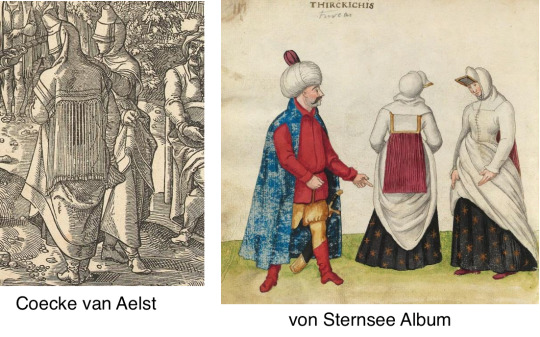
(Coecke van Aelst's woodcuts were identified as the source for the von Sternsee album's illustration in Katherine Bond's 2018 dissertation.)
Copy of a copy of what?
In spite of the problems it causes, copying from other artists' work was common in costume albums (Bond 2018). Considering that the artists did not visit all the cultures they illustrated, this is unsurprising. Some images were copied repeatedly, and the artist misunderstanding the source material wasn't the only source of distortion. Artists also made up details to compensate for bare-bones source material.
This simple line black-and-white print of an Irish woman wearing a léine (linen tunic), brat (Irish mantle), and headwear was used by several artists, all of whom made changes and additions. The first copy in this post is the most faithful to the original, but it still adds long sleeves and eyelet holes on the neckline to the léine. The coloring of the headwear suggests a wool hat crested with a tuft of horsehair and having a linen roll at the bottom. The coloring also gives the brat a contrasting lining.
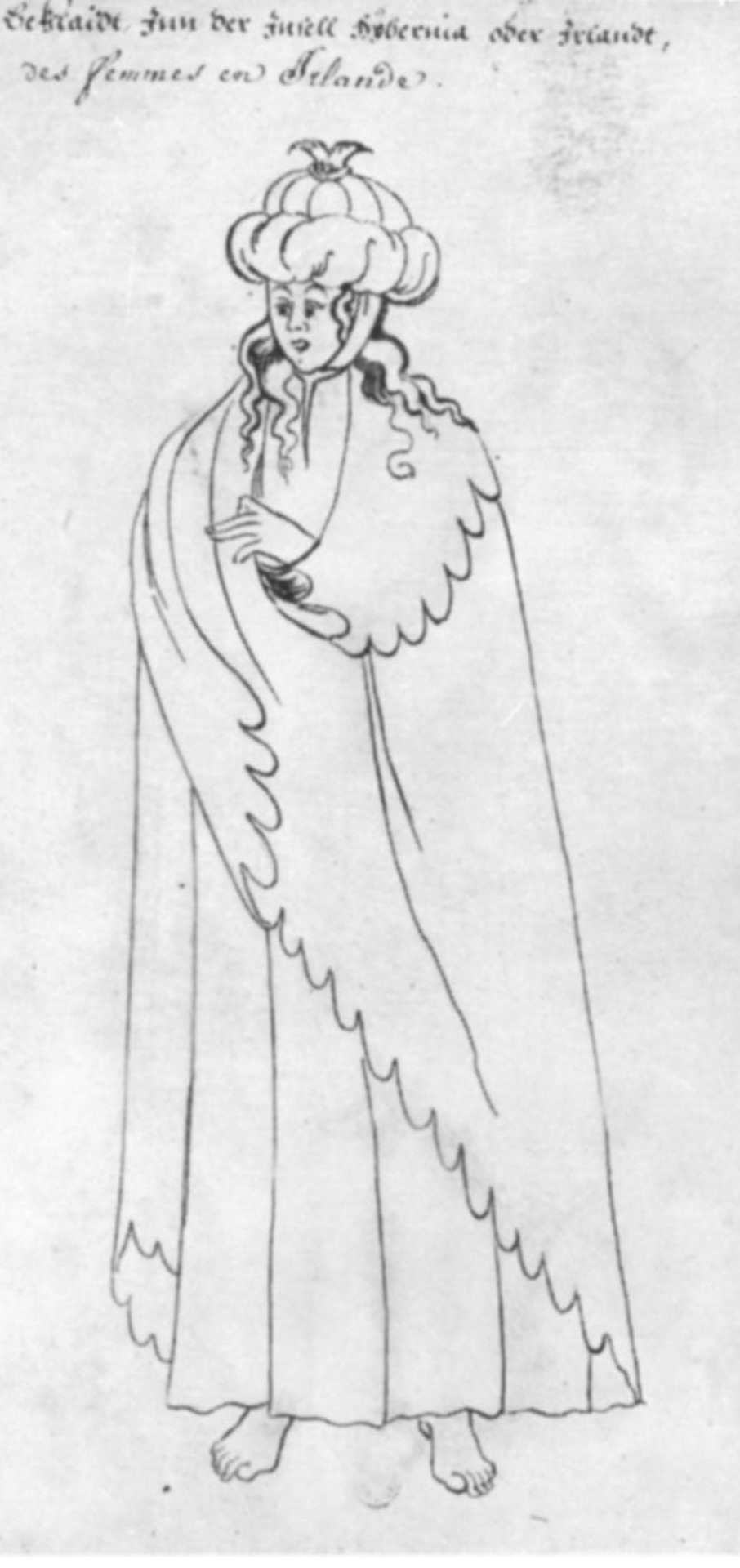

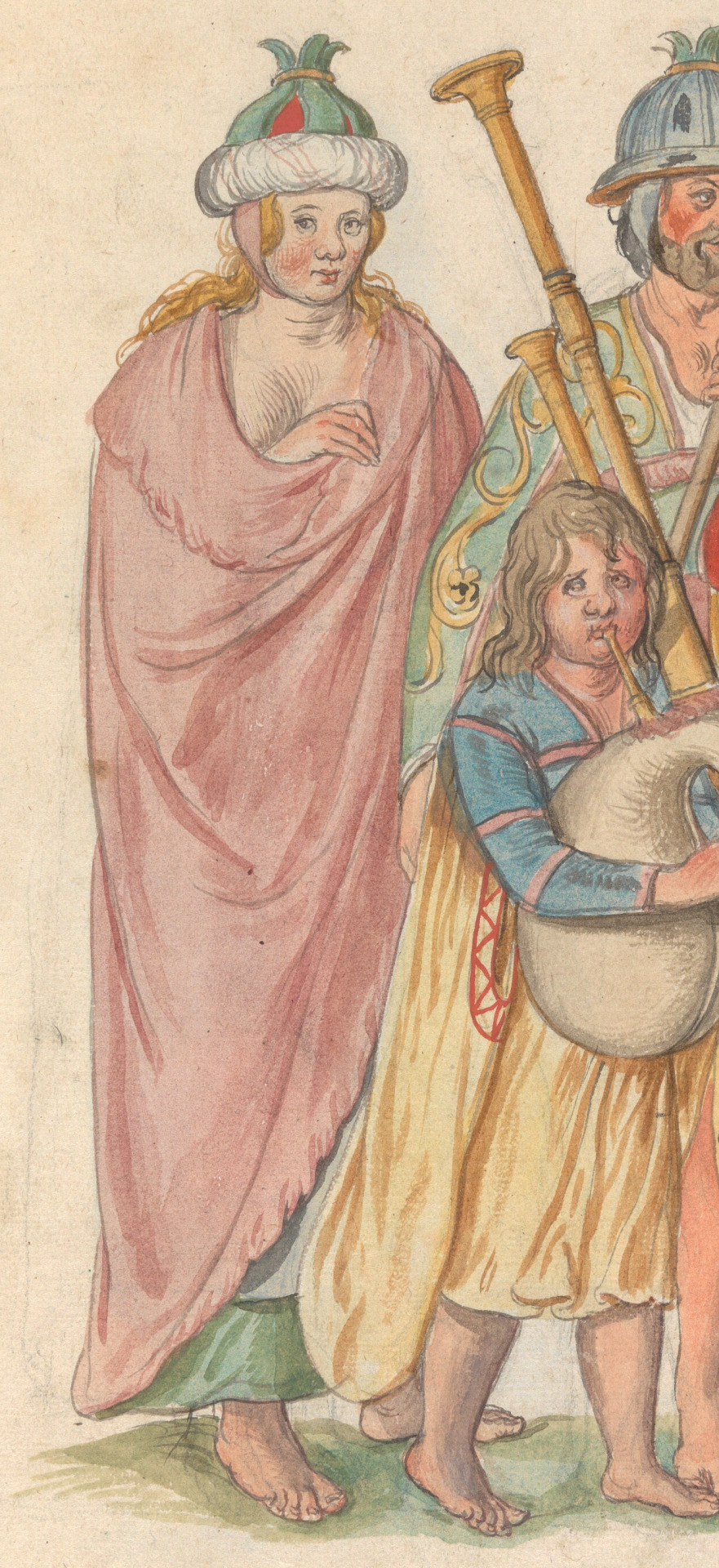

The second knockoff is the most famous. It comes from Lucas De Heere's illustration which purportedly shows Irish people in service to King Henry VIII. This is some thing De Heere couldn't have actually seen, as he moved to England 20 years after Henry VIII died and never went to Ireland at all. De Heere took the most liberties with his version. His Irish woman appears to be topless under her brat. The bottom of her léine has much less volume than the original, and De Heere has added an apron. For the hat, De Heere has replaced the crest with triangles of green wool.
Unlike De Heere's version, the final version is mostly loyal to the cut shown in the original, but it makes some unlikely suggestions for the materials. The léine appears to be green silk brocade. The brat also appears to be silk. Accounts from people who actually went to Ireland in the 16th and early 17th centuries state that these garments were made of linen and wool, respectively. Both the hat and its crest are now completely made of linen.
Chronological distortion:
The heavy use of copying in costume books also has the potential to mislead us in terms of when these fashions were worn, because the original images may be significantly older than publication year of the books that copy them. For example, the dress of Livonian women shown in Hans Weigel's 1577 book was almost certainly copied from Albrecht Dürer's 1521 watercolors. Weigel used references that were more than half a century old, but described them as if they were contemporary fashion in 1577.
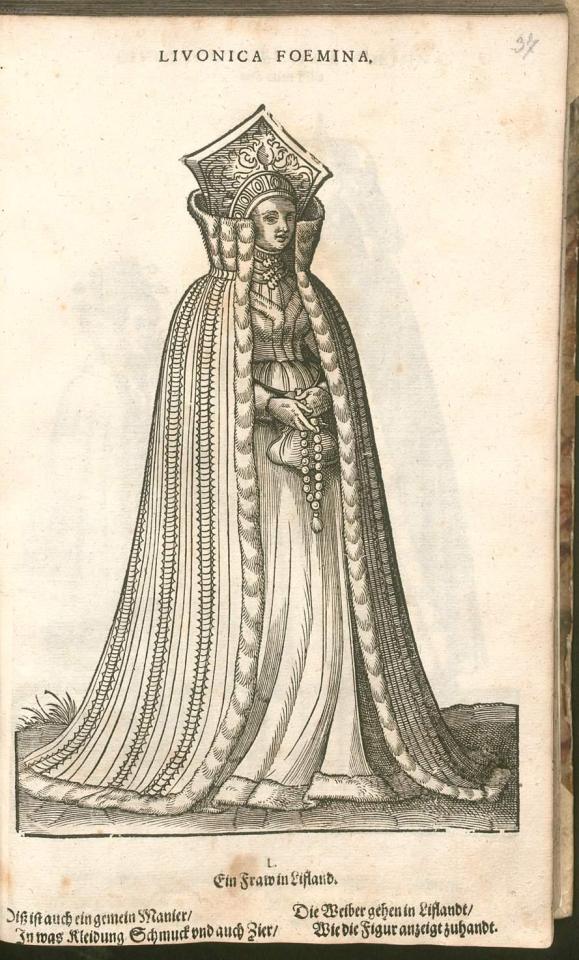
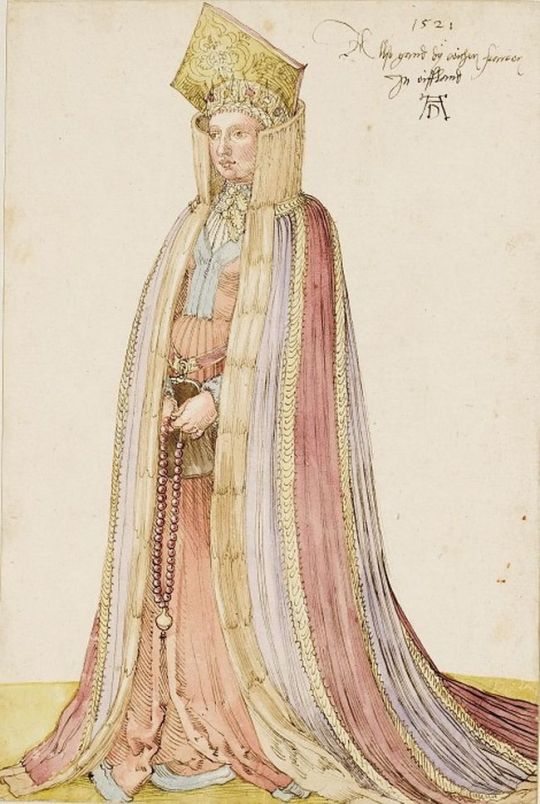
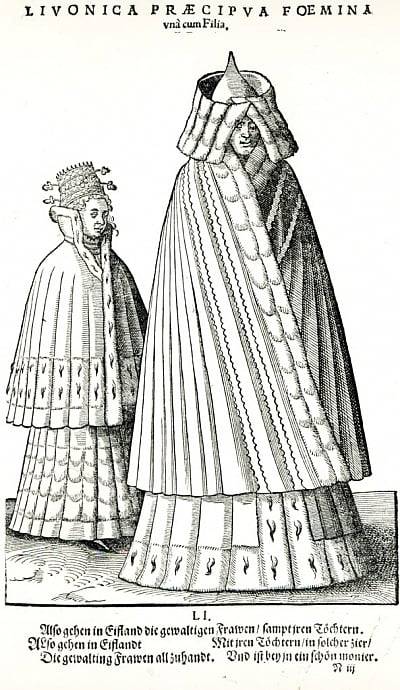
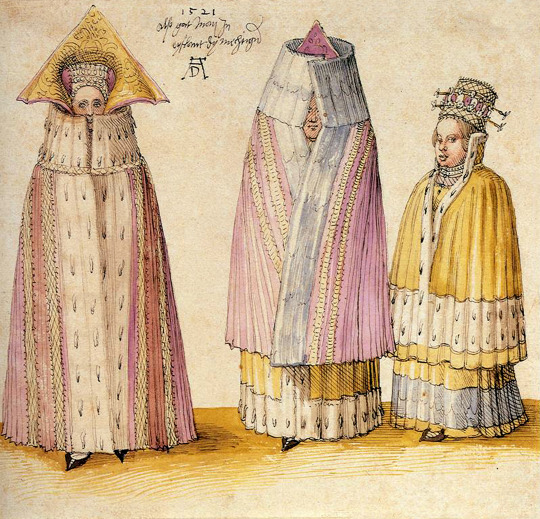
Even when costume book images are accurate portrayals of their source material, many of them lack the detail needed to identify seams, fabric types, or garment understructures. How do we deal with these problems when attempting to reconstruct what the people shown in these books actually wore?
What do we do about it?
I am not saying that we should discard these things completely as sources. Dress historians as respected as Patterns of Fashion author Janet Arnold and The Tudor Tailor authors Jane Malcolm and Ninya Mikhaila have used costume book illustrations. I definitely know less about 16th c. dress history than Jane and Ninya. I am just saying we shouldn't use them uncritically.
First, do some research on the costume book you're looking at. When was it created? Do the illustrations look suspiciously similar to those in other books? (Google image search and pinterest can be helpful for identifying this.) Did the creator, like Hans Weigel, have a particular bias they were advancing? Did they actually visit the cultures they portrayed? Christoph Weiditz actually traveled quite a bit, but he did not visit the British Isles, so his Irish and English women are probably based on someone else's art (Bond 2018). A lot of the scholarly publications about costume books are frustratingly paywalled, but some of them can be accessed for free via researchgate or academia.edu.
Avoid using copies when possible, even if the copies are more realistic-looking or more detailed art. As I discussed in the examples above, artists change things when they copy. Publication dates of copies can also be misleading in terms of dating clothing styles.
Find other sources such as: written descriptions from the time period, extant historical garments, more detailed art depicting similar fashions in related cultures, and art made by people from the culture you are studying. Period written descriptions can yield information about materials used, colors, and other details. Extant garments are your best source for information on cut and construction (unless you are lucky enough to have an extant tailor's manual from your period and culture). Detailed art depicting similar fashions can offer suggestions to fill in for missing information on construction, materials, and embellishments. Art created by the culture is valuable for identifying inaccuracies created by bigoted or ignorant artists.
Finally, remember that it's okay to not know everything. There are gaps in our knowledge about what people wore 500 years ago that will probably never be filled without a time machine. Sometimes you just have to make a plausible guess and move on. Don't let yourself get so paralyzed by doing research that you never complete the garment reconstruction/art/tumblr post you were doing the research for.
Bibliography:
Bond, K. L. (2018). Costume Albums in Charles V’s Habsburg Empire (1528-1549). https://doi.org/10.17863/CAM.25054
Dunlevy, Mairead (1989). Dress in Ireland. B. T. Batsford LTD, London.
Ilg, Ulrike. (2004). The Cultural Significance of Costume Books Sixteenth-Century Europe. In Catherine Richardson (ed.), Clothing Culture, 1350-1650 (p. 29-47). Ashgate.
McClintock, H. F. (1943). Old Irish and Highland Dress. Dundalgan Press, Dundalk.
McClintock, H. F. (1953). Some Hitherto Unpublished Pictures of Sixteenth Century Irish People, and the Costumes Appearing in Them. The Journal of the Royal Society of Antiquaries of Ireland, 83(2), 150-155. https://www.jstor.org/stable/25510871
Costume Books mentioned:
Amman, Jost. Gynaeceum, sive Theatrum mulierum.
The Costume Album of Christoph von Sternsee. not available on-line. Katherine Bond's research is your best source for this one.
Desprez, François. Recueil de la diversité des habits.
De Heere, Lucas. Corte Beschryvinghe van Engheland, Schotland, ende Irland.
Théâtre de tous les peuples et nations de la terre avec leurs habits et ornemens divers, tant anciens que modernes, diligemment depeints au naturel par Luc Dheere peintre et sculpteur Gantois.
Vecellio, Cesare, and Gratilianus, Sulstatius. Habiti antichi et moderni di tutto il Mondo di Cesare Vecellio.
Trachtenbuch des Christoph Weiditz
Weigel, Hans, and Amman, Jost. Habitus praecipuorum populorum, tam virorum quam foeminarum singulari arte depicti.
Kostüme der Männer und Frauen in Augsburg und Nürnberg, Deutschland, Europa, Orient und Afrika
Kostüme und Sittenbilder des 16. Jahrhunderts aus West- und Osteuropa, Orient, der Neuen Welt und Afrika
costume prints by an unknown artist, in the Bibliothèque nationale de France, Cabinet des Estampes. I cannot find this one online. image taken from McClintock 1953.
#dress history#historical fashion#art#16th century#17th century#historical costuming#historical dress#cw whorephobia#cw racism#irish dress#leine#irish mantle#reenactment#costume album
197 notes
·
View notes
Text
A Plutarchian Woodcut Wednesday
We’re spending our Woodcut Wednesday with this stunning sixteenth-century edition of Plutarch’s classic Parallel Lives featuring the work of artists Jost Amman and Tobias Stimmer.

The allegory of Fama, otherwise known as Fame or Renown, by Tobias Stimmer opens Plutarch’s Parallel Lives on the title page.

Various scenes from the life of the legendary Athenian monarch Theseus, including the hunt of the Calydonian boar and the hero throwing Sciron off a cliff edge. Plutarch pairs the Greek Theseus with the Roman Romulus.

The founding of the city of Rome under Romulus. The murder depicted in the foreground could be Romulus slaying Remus in the dispute over where Rome ought to be built.
Plutarch (ca. 46-after 120 A.D.) was born under Roman rule in Chaeronea, Boeotia, to a wealthy and established Greek family. Plutarch traveled to Athens in the mid-60s to study a variety of subjects, including medicine, physics, Latin, and philosophy. Though they were technically the conquering rulers, Romans at the time valued their Greek subjects’ culture of learning, and Plutarch was among those invited to tour Italy as a lecturer. Plutarch’s moral and philosophical lessons enjoyed success and formed the basis of his later written works. Parallel Lives was penned towards the end of Plutarch’s life when he had returned to Greece and was serving as a statesman and head priest of Apollo.

The unfortunate demise of the scholar Archimedes at the hands of Marcellus’ forces as they sack Syracuse. Plutarch relates that Marcellus’ greatest regret was the death of the famous mathematician.
Parallel Lives (Gk., Bioi paralleloi) is a moralistic set of biographies that examines the lives of notable Greek men and their Roman counterparts. The biographies are moralistic in the sense that Plutarch did not intend to write historically accurate accounts but rather wanted to draw out the lessons to be learned from the examples, both good and bad, of the lives of famous Greek and Roman individuals. Parallel Lives had a profound influence on readers from Plutarch’s contemporaries in the Roman Empire up through to the Middle Ages and early Renaissance. For example, William Shakespeare drew heavily on Plutarch’s Parallel Lives to write the plays Coriolanus, Timon of Athens, Antony and Cleopatra, and Julius Caesar.

Coriolanus and his forces, in the Volscian camp, hear the pleas of his mother, wife, and the women of Rome to stop his attack on the city. Coriolanus relents and the women are later honored with the building of a temple to the goddess Fortuna.
The edition of Parallel Lives featured in this post was printed by Frankfurt am Main publisher Sigmund Feyerabend (1528-1590) in 1580. The text is the Latin translation of Heidelberg University scholar Wilhelm Xylander (1532-1576), who famously produced the first Latin translation of Marcus Aurelius’ Meditations. The woodcut illustrations are the work of the prolific Swiss-German artist Jost Amman (1539-1591) and Swiss painter Tobias Stimmer (1539-1584). As an interesting sidenote, several of the woodcuts appearing in this edition of Plutarch were recycled from Feyerabend’s 1568 edition of Livy’s History of Rome.
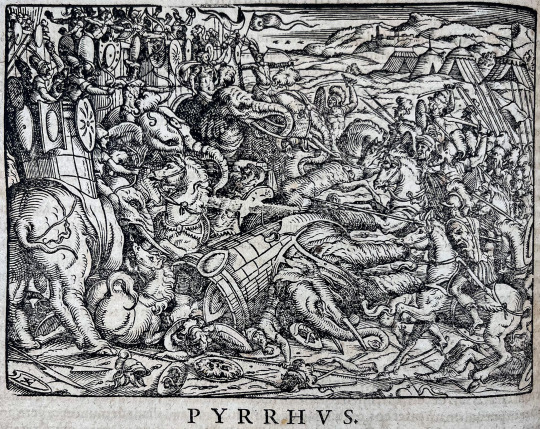
Battle between two armies, one on horseback and the other on war elephants. This generic illustration is repeated for Plutarch’s Life of Alexander (the Great) and Life of Pyrrhus (of Epirus). The former famously fought against forces that used elephants; the latter notably used them in battle.

As a change of pace from all the foregoing imagery of bloodshed and gore, we'd like to end with this elaborate woodcut of Aristotle seated at a table of scholars. Aristotle is not among the lives covered in the Bioi paralleloi, but this edition adds a brief biography of the philosopher by Guarino Veronese.
Images from: Plutarch. Vitae illustrium vivorum Graecorum et Romanorum. Frankfurt am Main: Sigmund Feyerabend, 1580. Catalog record: https://bit.ly/3DUnWhl
64 notes
·
View notes
Text
The British Empire Was Much Worse Than You Realize | The New Yorker
March 28, 2022
A red lion from the British royal coat of arms holding a globe.
Liberal imperialism, Caroline Elkins argues, gained resilience from its ability to absorb and neutralize objections. Illustration by Ben Jones
"At the height of the British Empire, just after the First World War, an island smaller than Kansas controlled roughly a quarter of the world’s population and landmass. To the architects of this colossus, the largest empire in history, each conquest was a moral achievement. Imperial tutelage, often imparted through the barrel of an Enfield, was delivering benighted peoples from the errors of their ways—child marriage, widow immolation, headhunting. Among the edifiers was a Devonshire-born rector’s son named Henry Hugh Tudor. Hughie, as he was known to Winston Churchill and his other chums, pops up so reliably in colonial outposts with outsized body counts that his story can seem a “Where’s Waldo?” of empire.
He’s Churchill’s garrison-mate in Bangalore in 1895—a time of “messes and barbarism,” the future Prime Minister complained in a note to his mum. As the century turns, Tudor is battling Boers on the veldt; then it’s back to India, and on to occupied Egypt. Following a decorated stint as a smoke-screen artist in the trenches of the First World War, he’s in command of a gendarmerie, nicknamed Tudor’s Toughs, that opens fire in a Dublin stadium in 1920—an assault during a search for I.R.A. assassins which leaves dozens of civilians dead or wounded. Prime Minister David Lloyd George delights in rumors that Tudor’s Toughs were killing two Sinn Féinners for every murdered loyalist. Later, even the military’s chief of staff marvelled at how nonchalantly the men spoke of those killings, tallying them up as though they were runs in a cricket match; Tudor and his “scallywags” were out of control. It didn’t matter: Churchill, soon to be Secretary of State for the Colonies, had Tudor’s back.
Imperial subjects, of course, sometimes found their own solutions to such problems. A hard-line British field marshal, atop the I.R.A. hit list, was gunned down in Belgravia in 1922. Tudor, worried he would be next, made himself scarce. By the following year, he and his Irish paramilitaries were propagating their tactics for suppressing natives in the British-controlled Mandate of Palestine, Churchill having decided that the violence-prone Tudor was just the fellow to train the colonial police. A letter from Tudor to Churchill that I recently came across crystallizes all the insouciance, cynicism, greed, callousness, and errant judgment of empire. He opens by telling Churchill that he’s just commanded his troops to slaughter Adwan Bedouins who had been marching on Amman to protest high taxes levied on them by their notoriously extravagant emir. This tribe was “invariably friendly to Great Britain,” Tudor writes, a touch ruefully. But, he adds, “politics are not my affair.”
Tudor had cheery news to impart, too. Not only could the Mandate be a “wonderful tourist country,” but prospectors had discovered vast sums’ worth of potash in the Dead Sea valley. Should Britain appropriate the resources and increase the policing budget, its difficulties in the region would “smooth out,” he told Churchill, assuring him that Palestinians would be easier to pacify than the Irish: “They are a different people, and it’s unlikely that the Arab if handled firmly will ever do much more than agitate and talk.”
In the twentieth century’s hierarchy of state-sponsored violence, Hitler’s Germany, Stalin’s Russia, and Hirohito’s Japan typically take top spots. The actions of a few European empires have invited harsh scrutiny, too—Belgium’s conduct in Congo, France’s in Algeria, and Portugal’s in Angola and Mozambique. Britain is rarely seen as among the worst offenders, given a reputation for decency that the Harvard historian Caroline Elkins has spent more than two decades trying to undermine. “Legacy of Violence” (Knopf), her astringent new history of the British Empire, brings detailed context to individual stories like Tudor’s. Visiting archives in a dozen countries over four continents, examining hundreds of oral histories, and drawing on the work of social historians and political theorists, Elkins traces the Empire’s arc across centuries and theatres of crisis. As the sole imperial power that remained a liberal democracy throughout the twentieth century, Britain claimed to be distinct from Europe’s colonial powers in its commitment to bringing rule of law, enlightened principles, and social progress to its colonies. Elkins contends that Britain’s use of systematic violence was no better than that of its rivals. The British were simply more skilled at hiding it."
32 notes
·
View notes
Note
your profile photo is from this artist https://twitter.com/ami_badran, you should credit them
((Done, I admit that I completely forgot about that.
I love their art, for more visit https://napoleonicimpressions.com/collections/tookunami-artist-collection-page/?ref=tookunami where you can actually get their creations for your home))
2 notes
·
View notes
Text
Some excerpts:
"... Murad's music deals with topics many artists are afraid to approach: the Israeli occupation, the violence of daily life as a Palestinian, and how he remains hopeful despite it all. While thirty-year-old Murad is Palestinian, he is also queer. And it is this convergence of identities that informs his work. “We [Palestinians] have the experience of queer people in most places of the world, but on top of that, we're also living under occupation,” Murad says.
By imbuing his music with his own personal (and political) touch, Murad is able to reshape his listener’s understanding of queer life in Palestine that goes beyond “Arabs are homophobic” and explores the intricacies of occupation, family, and conservatism that those in the West also experience in their own lives. “I've always been about breaking stereotypes,” he says. “The mindset that I’ve always had is to show something completely opposite of what you’d expect to see and the sounds you’d expect to hear.” ..."
-
"... While Murad admits he was lucky to be able to study in America, it wasn’t what he expected. “I imagined a big city like New York. So when I ended up there, it was definitely a shock. It seemed like it was even smaller than Jerusalem,” Murad says. “When I would say I’m Palestinian, no one would know where that is. They would say Pakistan or something, and I’d have to say ‘Where Jesus was born’ to connect the dots for them,” Murad adds with a forced laugh."

"... Leaving for America is difficult enough as a Palestinian student. They first have to apply for a U.S. student visa, then most cross the border into Jordan via Allenby/King Hussein Bridge (a crossing controlled by Israel) and leave from Amman. All the while, they risk being detained or denied permission to travel altogether. To return to Palestine after leaving illustrates a remarkable degree of loyalty to one’s homeland.
Murad knows this, which is why in addition to writing and producing his own music, he has dedicated himself to improving opportunities for Palestinian artists so that they choose to stay. Part of this is out of Murad’s control — according to Murad, without international attention and financial support flowing into Palestine, artists will continue to be forced to leave to chase after the resources those in the West take for granted. ..."
3 notes
·
View notes
Text
«Lies, my boy, are immediately recognisable, because there are two types: there are lies that have short legs and lies that have a long nose»
Carlo Collodi , The Adventures of Pinocchio
Lies and false truths constructed on the table, genocide and forced exodus to seize energy resources.
by Piero Angelo De Ruvo
VERSIONE IN ITALIANO
Never before have the words that master Geppetto, a psychoanalyst ante litteram, addressed to his puppet been so timely. Lies that have effects on the mind, on the body, on relationships with others, on relationships between states.
How many conflicts – Syria, Libya, Afghanistan, Iraq – began thanks to artfully packaged lies, conflicts that continue even today with the sole purpose of plundering the energy resources of countries that have them in abundance and which Europe, but not only, desperately needs, with the complicity of the energy lobbies.
A Review of Lies Illustrated by Former Interpol Official in Jordan
The proof of these lies is found in the book “Mediterraneo. Same blood, same mud”, written by Antonio Evangelista and illustrated to Gospa News in an exclusive interview
“ is a bit of a review of the lies that have been told about the conflicts in the Balkans, in Libya, in Syria, lies that have now been verified with official sources, interviews with American officials, UN and embassy documents or secret documents that have now been declassified, like the Canadian ones, where we read a different story compared to what was the narrative of the time.”
This is according to author Antonio Evangelista , a former police director, who also served in the United Nations international police, and in Interpol as attaché at the Italian embassy in Amman, Jordan, dealing with war crimes, terrorism and Balkan mafia.
0 notes
Text
Pushing English-spanish Thesaurus
Click any word or phrase to go to its thesaurus page. A pushing trigger is the activity that shocks the protecting team into action. For some groups, journalism trigger will certainly be any hefty touch from the defender. For others, it will be a specific minute of the game or the sphere going into a particular area of the pitch.
The word in the example sentence does not match the entry word.
The brand-new edition of the dictionary is getting an excellent press.
Press n presa nfThe press is a training workout for weightlifters.
But when pressed, HSSA was incapable to supply adoption documents or proof the pets had also been refined for intake at the sanctuary before being sent to regional saves.
A pressing trigger is the action that shocks the safeguarding group right into activity.
Impressment right into solution, esp. marine or armed forces service. The people who deal with newspapers and magazines; journalists. These examples are programmatically assembled from numerous online resources to show existing usage of words 'pressing.' Any opinions revealed in the examples do not represent those of Merriam-Webster or its editors.
Various Other Words For Pressing
Journalism is/are always thinking about the personal lives of renowned people. The printers are pressing their insurance claim for higher pay. Burning, sobbing, dire, emerging, exigent, necessary, immediate, urgent. Blinken's journey complies with fraught meetings with Arab leaders in the Jordanian resources Amman, where he was pushed repetitively to ask for a cease-fire in Gaza by Egyptian, Jordanian, Saudi, Qatari and Emirati mediators and a senior Palestinian authorities. The head of state pushed Xi to use China's influence with Iran to advise Tehran and its proxies to avoid the war from broadening into a regional conflict and made clear the U.S. issues concerning Ukraine, the official claimed. Because of this, C-section children can likewise have a conehead if their head is pressed against the wall surfaces of the womb or cervix before distribution.
Pressing questions for the Chiefs, Eagles, 49ers and six other NFL contenders: Sando’s Pick Six - The Athletic
Pressing questions for the Chiefs, Eagles, 49ers and six other NFL contenders: Sando’s Pick Six.
Posted: Mon, 20 Nov 2023 08:00:00 GMT [source]

The new version of the dictionary is obtaining excellent press. Utilized to speak about exactly how usually or how well or severely somebody or something is defined in papers, magazines, etc. But her sibling continued, joining pressures with 2 various other armed homeowners, cellphone video showed.
Closer, and suddenly, also as the girl looked directly at him, a spear travelled through the heart of Number 3. Much more closely upon Twelve and Three, and the change made it impossible for the girl to see his face also in the extra frequent moonlit places. Me so closely that I could not transform when I heard an activity behind me, and kept in mind that the noise of the fight anthem had actually ceased. Interview a conference in which information is given to reporters.
youtube
How To Make Use Of Pressing In A Sentence
Frequently pressings The material, such as juice or grape skins, generated by or left over after pressing. These examples are programmatically compiled from different on-line sources to illustrate existing use of words 'press.' Any type of viewpoints shared in the instances do not represent those of Merriam-Webster or its editors. But when pushed, HSSA was not able to offer adoption records or proof the animals had even been refined for consumption at the sanctuary prior to being sent out to local rescues. But sharper and closer stress and anxieties than any kind of connected with rights to lands and homes were pushing upon Alessandro and Ramona. His strong hands lay palm downwards on the arms of his chair, pushing them hard Pressing the dodge switch at the correct time creates her to temporarily rupture into an invincible group of crows.

youtube
Individuals that work for newspapers, publications, and so on. These instances are programmatically assembled from numerous on the internet sources to illustrate present use of words 'press on.' Any kind of viewpoints expressed in the examples do not represent those of Merriam-Webster or its editors. The 10 Bands One Reason campaign, currently in its 10th year, will release records by Anthrax, Lissie, R.L. Burnside, Face to Face, the Gaslight Anthem, and others, continued pink plastic in October and November. French taxis were pushed right into service as army transportations.
Phrases Containing Press
It was a substantial comparison from Ole Gunnar Solskjaer who, according to The Athletic, did not instructor pressing since he believed his gamer closest to the circumstance ought to naturally be capable of closing down the male on the ball. See Google Translate's machine translation of 'pressing'. The backup computer was pushed right into solution when the main computer fell short. Retired doctors and registered nurses were pressed into service to aid take care of the wounded. To squash or ravel with your hand, an iron, and so on.
youtube
1 note
·
View note
Text
Unhistoric Kindness
The Smartest Giant in Town
By Julia Donaldson
Illustrated by Axel Scheffler
MacMillan Children’s Books, 2003
I first read The Smartest Giant in Town to a group of six to ten year olds attending an English language summer school in Amman, Jordan. I knew nothing about it, other than that I had to interact with the kids while telling it, ask them questions, get them to guess what happens next…
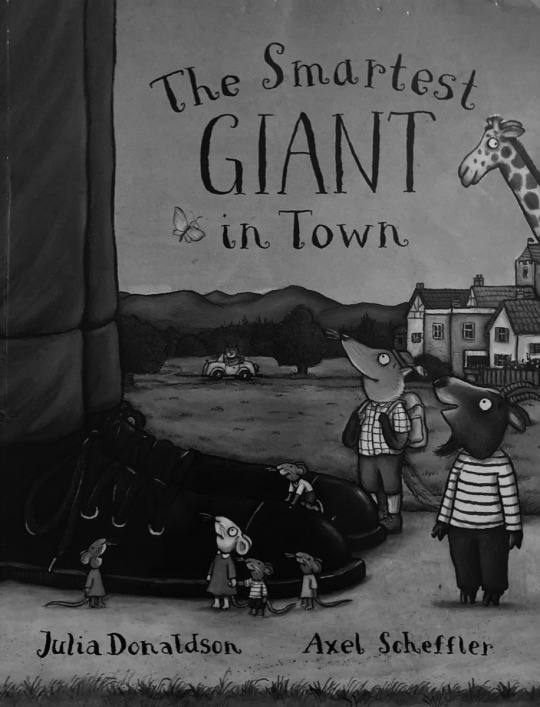
View On WordPress
#Amman#Axel Scheffler#Book Review#Children#Children&039;s Literature#Colleague#Death#George Eliot#Jordan#Julia Donaldson#Literature#Madeleine#Memories#Middlemarch#Picture Books#Review#Staffroom
0 notes
Photo

2006 Marchesa Luisa Casati taking a walk by Olga Balabanova.
#2006#illustration#marchesa luisa casati#La Marchesa Luisa Casati#louisa amman#olga balabanova#balabanova#luisa casati#la marquesa luisa casati#la Marquise#la marquise casati stampa#marquise casati#Marquise luisa casati#marquise#marchesa#marchesa luisa casat#luisa amman
11 notes
·
View notes
Text
Domus galilae

John Paul II, who illustrated a new era affinity between Catholics and Jews, stressed the need to appreciate the Jewish roots in order to live an authentic Christianity. The center is designed as a place where Christians would learn about the living tradition of Israel following the footsteps of early Christian saints “who have returned to their Hebrew roots by studying the meaning of prayer, celebrations and Hebrew liturgies”. The mount of the Beatitudes The International Center Domus Galilaeae, is located near the summit of the hill known as the mount of the Beatitudes which rises quite rapidly almost 300 meters (900 hundred feet) above sea level, in front of Capernaum and Tabgah, the place of the multiplication of the loaves and fishes. BLDGBLOG), and Beatrice Galilee (writer, curator, DomusWeb, The Gopher Hole). On May 13, 2009, he received an honorary doctorate by the Pontifical John Paul II Institute for Studies on Marriage and Family. See the latest news and architecture related to Domus, only on ArchDaily. He is not only the architect but also the innovator of what became in 1964 the Neocatechumenal Way in the slums of Palomeras Altas in Madrid. A Spanish artist who studied fine art at the Royal Academy of San Fernando in Madrid and received in 1959 the Special National Award for painting. Within sight are the scenes of many of the events of Jesus ministry in Galilee, including the town of Capernaum 3km away, where he made his home. Truly, 'God is waiting for you on this mountain. In the center of the library is an ancient Torah.įrancisco José Argüello Gómez y Wirtz more fluently called Kiko Arguello Wirtz was born in Spain January 9, 1939. Bautista 2 23:52: When a place is run on LOVE, it becomes the best place to be. It was inaugurated by Pope John Paul II during his visit for the Holy Land Millennium. There are 37 Christian Arab workers, 32 Arab Muslims, 21 technicians, 20 Jews, Druze and 10 Maronites. Managed by the Catholic organization Neocatechumenal Way, Domus Galilaeae employs about 150 full-time people, including workers, technicians and volunteers. A cause of great rejoicing for the Mother Church, especially for the parishes of Madaba, Amman and Zarqa. The opening of the site was held in 2000. El Centro Internacional Domus Galilaeae o Domus Galilea (en Hebreo: ) es un centro de formación y retiro en Israel, que desde el año 1999, acoge un punto de oración para las personas pertenecientes al Camino Neocatecumenal y para la Iglesia católica. KORAZIM - In Domus Galilaelae, where seminarians from all over the world are trained to serve the Church, three young men were ordained priests by His Beatitude Pierbattista Pizzaballa, Latin Patriarch of Jerusalem, on Saturday, June 11th. This magnificent building of Domus Galilaeae is in the lower galilee dominating the Sea of Galilee and the Mont of Beatitudes.ĭomus Galilaeae first stone was laid in January 1999, the building was built in a short period of time with traditional Tuscan stone.

0 notes